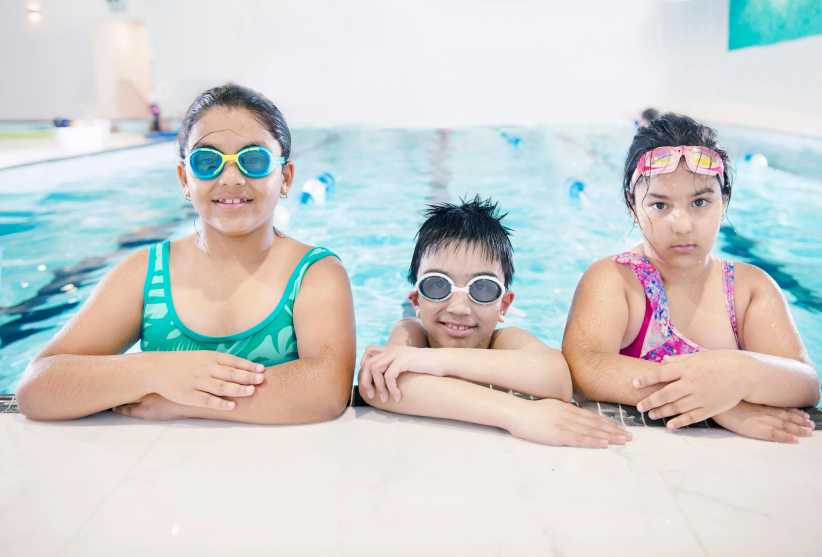On a brisk
Monday morning in a classroom in Chelsea, ten children are gathered in a
semi-circle singing “Twinkle Twinkle Little Star.” They smile widely at their
teacher, Donna A.,
who is sitting in a chair in front of them, and softly giggle when one student
enthusiastically jumps out of his seat at the lyrics “like a diamond in the
sky.” Around them, brightly colored posters adorn the walls and off to the
side, there are labeled cubbyholes, each housing one child’s belongings. —
As the children,
who are between four and five years old, continue singing, one boy with a mop
of curly brown hair is distracted by his reflection in the mirror to his right.
He jumps toward it and makes faces, laughing hysterically at what he sees.
“Come back to
the circle. Sit in your seat nicely,” Donna and a teaching assistant remind
him.
Some of the
other children stand up and sit back down during the singing session. One
stares intently at the bright orange paper band around his wrist, which all of
the students are wearing.
“Who’s ready to
sing a solo?” Donna asks the class. One by one, eager students head to the
front of the circle to perform a song of their choice.
At first glance,
this may seem like any kindergarten classroom in a New York City school, but these children attend the
Association for Metroarea Autistic Children, Inc. (AMAC)—a National Association for the
Education of Young Children accredited school.
Aside from their
love of silly songs and even sillier dances, the diagnosis of autism bonds
these young children together. Categorized as a developmental disorder, autism
can cause significant social, communication and behavioral challenges.
According to the Center for Disease Control and Prevention, autism affects one
in every 110 children in the United States. Ranging from very mild to severe,
children with autism may suffer from delayed speech and language skills, repeat
words and phrases over and over, get upset by minor
changes or adjustments to a
routine, and have obsessive interests, among other behaviors. Although many
schools accept autistic children into their special education programs, they
are often not equipped to give these students the individualized attention they
need.
That is where AMAC comes in. Founded in 1962, AMAC is a year-round school for students ages
two and a half to 21 years old who suffer from all levels of the autism
spectrum. About 200 students attend the school, where classes remain very small
and children are placed based on their individual needs. Class size ranges from
six to ten students, all with a teacher and at least one teaching assistant.
Children with severe autism are placed in the smaller groups with greater
supervision.
“The small class
size really allows teachers to work with the students and give them the proper
amount of attention,” Miriam DiOrio, Director of Clinical Services at AMAC says. “In [certain] classes, they are
often able to work one-on-one with the children.”

AMAC teaches students not only academic
subjects, but also social and communication skills. This is done through the
Applied Behavior Analysis (ABA) approach, a scientifically based, state
approved methodology. It relies on intensive behavioral intervention and
teaches targeted skills and behaviors. AMAC faculty and staff, which consist of
teachers with special education certification, trained teaching assistants and
behavioral analysts, all reinforce behaviors through a reward system—hence, the
orange bracelets.
When walking
through the busy hallways of the school where students file in and out of
classrooms and teachers sing songs about moving on to a new activity, one will find
that students have their own plastic boxes filled with snacks. Each container
is individually assembled according to the child’s personal preferences—some
filled with pretzels, cookies or small candies like M&Ms.
“When students
complete a certain task, they are then rewarded with a small piece of food,
which reinforces that it is a good behavior they should continue doing,” DiOrio
says.
Depending on the
severity of the child’s condition, the rewarded task may include verbalizing a
desire or following a routine or it may be part of a learning activity.
For example,
during one of the day’s activities for the school-aged children (ages five-13),
students and teachers sit across from each other, one-on-one, and practice word
recognition. In front of the children are bowls filled with their favorite
snacks.
“Show me cat,” a
teacher assistant says to the student sitting across from him. He holds up
three pieces of paper with different words on them. When the child points to
the word “cat,” the teacher gives him one M&M.
“Good job!” the
assistant says, as the boy happily accepts his treat.
Twice a day,
children in each classroom can purchase snacks, candy and small toys from a
reward cart. They are given currency—younger children receive wristbands and
the older students get plastic fake dollar bills—periodically throughout the
day for good behavior.
When the reward
cart visits, children line up and their currency is counted. Students can
choose to purchase various items with what they have or wait until they collect
more currency for something that is more expensive.
“If there’s a
toy or item a student really wants, he has the option to save for it over a
period of time,” DiOrio says. “So students are also learning a real life lesson
– the value of saving.”
Teachers at AMAC often face challenges that those in
other schools do not. For example, children with autism often have a difficult
time coping with changes to routine.
Jessica F.,
who has taught at AMAC for the past four years, said one of her
new students has had a particularly hard time with transitioning to different
tasks throughout the day.
“He will often
throw tantrums when it’s time to leave one task and go to another,” she says.
The solution?
Finn made a picture book for the student chronicling the different activities
of his day. She took photos of him partaking in reading lessons, doing
arithmetic, taking art classes and playing games on a computer and attached
them to the pages of the book. Each time he completes an activity, he tears the
picture out of the book and knows it is time to move to the next task.
“This helps him
transition,” Finn says. “He knows he has to get through things…like math, to
get to something he likes, like computers.”
Upstairs at AMAC’s high school, a New
York State registered school that is able to grant local, IEP (Individualized Education Program) and
Regents Diplomas, things are
run in a similar manner.
Students are
rewarded for good behavior, and class sizes are determined by the teenagers’
abilities. Like any other high school, students at AMAC are taught mathematics, English, science
and social studies.
In one of the
classrooms, students are learning economics and the concept of a monopoly.
“So, basically,
it’s when one business tries to wipe out all other corporations?” a student
asks his teacher. “They’re trying to wipe out their competition.”
“Exactly!” the
teacher exclaims. “You got it.”
Just then
there’s a knock on the door. The reward cart is making its afternoon visit.
Students begin
lining up at the cart.
“How much for
the Welch’s Fruit Snacks?” one student asks.
“Four dollars,”
comes the response.
The student buys
the fruit snacks, but mutters to himself on the way back to his seat. “Four dollars
for Welch’s Fruit Snacks—that’s pretty steep!”
For parents,
being involved in their child’s education is a very important aspect of the AMAC experience. A communication notebook, in
which teachers update parents on their child’s progress, is sent home with
students every day. Parents also have the option to write notes to their
child’s teacher about any concerns they may have.
Vernalize
Cameron, whose son Mirembe, 4, has attended AMAC for the past two years, says that this
constant communication has been an integral part of her child’s education.
“Knowing what is
going on at school is great because it allows me to bring the lessons home,”
she says.
Cameron, who
praises AMAC’s system of rewards, says she continues
to reward Mirembe after the school day is over because the approach really
works.
“Before he came
here, he would constantly throw tantrums,” she remembers. “He wouldn’t want to
go outside. If he wanted something, he didn’t know how to express himself. Now,
things are so much more peaceful and he doesn’t get agitated as much.”
Yet, Cameron and
school officials emphasize that AMAC
offers much more than a strict regimen of behavior analysis and rewards.
“We also provide
a loving and nurturing environment that is warm and inviting,” says Arnold R.
Cohen, M.D., the Medical Director and one of the founders of AMAC.
Cohen notes that
in addition to regular school activities, AMAC holds a number of specialized events
that students, parents and faculty alike greatly enjoy, including fundraisers,
concerts and holiday celebrations—most notably a Thanksgiving meal that
includes homemade dishes from parents and even celebrity chefs.
“It’s quite the
feast,” Cohen says with a smile.
Perhaps it is
this mix of a proven scientific method and the warm nature of the school that
accounts for AMAC’s success. Last year, high school
student Naresh Cintron graduated and went on to attend Lehman College. Also, the entire preschool class
graduated into less restrictive schools, a goal officials at AMAC are very proud of and hope to achieve
again this year.
Cameron says she
believes her son’s experience at AMAC has prepared him to move to a mainstream
school after this year.
“He’s come a
long way,” she says, “and with everything he’s learned here, I am much more
comfortable with the idea of him attending a regular school.”
For more information, visit amac.org.
Photograph by Andrew Schwartz





















